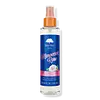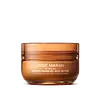Tree Hut Moroccan Rose Bare Post Shave Soothing Mist Versus Josie Maran Whipped Argan Oil Body Butter
What's inside
What's inside
 Key Ingredients
Key Ingredients

 Benefits
Benefits

 Concerns
Concerns

 Ingredients Side-by-side
Ingredients Side-by-side

Water
Skin ConditioningSd Alcohol 40-B
AstringentGlycerin
HumectantPolysorbate 20
EmulsifyingPEG-40 Hydrogenated Castor Oil
EmulsifyingPropylene Glycol
HumectantPanthenol
Skin ConditioningMenthyl Lactate
MaskingParfum
MaskingVanilla Planifolia Fruit Extract
Skin ConditioningGardenia Taitensis Flower Extract
Skin ConditioningCocos Nucifera Oil
MaskingAloe Barbadensis Leaf Juice
Skin ConditioningAllantoin
Skin ConditioningCitrus Grandis Peel Oil
MaskingCitrus Aurantium Dulcis Oil
MaskingAvena Sativa Kernel Extract
AbrasivePotassium Sorbate
PreservativePhenoxyethanol
PreservativeEthylhexylglycerin
Skin ConditioningCaprylyl Glycol
EmollientDisodium EDTA
Water, Sd Alcohol 40-B, Glycerin, Polysorbate 20, PEG-40 Hydrogenated Castor Oil, Propylene Glycol, Panthenol, Menthyl Lactate, Parfum, Vanilla Planifolia Fruit Extract, Gardenia Taitensis Flower Extract, Cocos Nucifera Oil, Aloe Barbadensis Leaf Juice, Allantoin, Citrus Grandis Peel Oil, Citrus Aurantium Dulcis Oil, Avena Sativa Kernel Extract, Potassium Sorbate, Phenoxyethanol, Ethylhexylglycerin, Caprylyl Glycol, Disodium EDTA
Water
Skin ConditioningArgania Spinosa Kernel Oil
EmollientCaprylic/Capric Triglyceride
MaskingHelianthus Annuus Seed Oil
EmollientGlyceryl Stearate
EmollientGlycerin
HumectantButyrospermum Parkii Butter
Skin ConditioningHydroxyethyl Acrylate/Sodium Acryloyldimethyl Taurate Copolymer
Emulsion StabilisingSqualane
EmollientCetearyl Glucoside
EmulsifyingCoco-Caprylate/Caprate
EmollientPolysorbate 60
EmulsifyingParfum
MaskingTocopherol
AntioxidantAloe Barbadensis Leaf Juice
Skin ConditioningPhenoxyethanol
PreservativeCetearyl Alcohol
EmollientPersea Gratissima Oil
Skin ConditioningAllantoin
Skin ConditioningCamellia Sinensis Leaf Extract
AntimicrobialSymphytum Officinale Leaf Extract
Skin ConditioningEthylhexylglycerin
Skin ConditioningPanthenol
Skin ConditioningHelianthus Annuus Flower Extract
Skin ConditioningAmyl Acetate
MaskingEthyl Butyrate
PerfumingHexyl Acetate
MaskingBeta-Carotene
Skin ConditioningWater, Argania Spinosa Kernel Oil, Caprylic/Capric Triglyceride, Helianthus Annuus Seed Oil, Glyceryl Stearate, Glycerin, Butyrospermum Parkii Butter, Hydroxyethyl Acrylate/Sodium Acryloyldimethyl Taurate Copolymer, Squalane, Cetearyl Glucoside, Coco-Caprylate/Caprate, Polysorbate 60, Parfum, Tocopherol, Aloe Barbadensis Leaf Juice, Phenoxyethanol, Cetearyl Alcohol, Persea Gratissima Oil, Allantoin, Camellia Sinensis Leaf Extract, Symphytum Officinale Leaf Extract, Ethylhexylglycerin, Panthenol, Helianthus Annuus Flower Extract, Amyl Acetate, Ethyl Butyrate, Hexyl Acetate, Beta-Carotene
Ingredients Explained
These ingredients are found in both products.
Ingredients higher up in an ingredient list are typically present in a larger amount.
Allantoin is a soothing ingredient known for its protective and moisturizingg properties. Because of this, it is often added to products with strong active ingredients.
Studies show higher concentrations of this ingredient can promote wound healing.
Though it can be derived from the comfrey plant, allantoin is produced synthetically for cosmetic products to ensure purity.
Learn more about AllantoinAloe Barbadensis Leaf Juice comes from leaves of the aloe plant. Aloe Barbadensis Leaf Juice is best known for helping to soothe sunburns. It is also anti-inflammatory, moisturizing, antiseptic, and can help heal wounds.
Aloe is packed with good stuff including Vitamins A, C, and E. These vitamins are antioxidants, which help fight free-radicals and the damage they may cause. Free-radicals are molecules that may damage your skin cells, such as pollution.
Aloe Barbadensis Leaf Juice also contains sugars. These sugars come in the form of monosaccharides and polysaccharides, folic acid, and choline. These sugars are able to help bind moisture to skin.
It also contains minerals such as calcium, 12 anthraquinones, fatty acids, amino acids, and Vitamin B12.
Learn more about Aloe Barbadensis Leaf JuiceEthylhexylglycerin (we can't pronounce this either) is commonly used as a preservative and skin softener. It is derived from glyceryl.
You might see Ethylhexylglycerin often paired with other preservatives such as phenoxyethanol. Ethylhexylglycerin has been found to increase the effectiveness of these other preservatives.
Glycerin is already naturally found in your skin. It helps moisturize and protect your skin.
A study from 2016 found glycerin to be more effective as a humectant than AHAs and hyaluronic acid.
As a humectant, it helps the skin stay hydrated by pulling moisture to your skin. The low molecular weight of glycerin allows it to pull moisture into the deeper layers of your skin.
Hydrated skin improves your skin barrier; Your skin barrier helps protect against irritants and bacteria.
Glycerin has also been found to have antimicrobial and antiviral properties. Due to these properties, glycerin is often used in wound and burn treatments.
In cosmetics, glycerin is usually derived from plants such as soybean or palm. However, it can also be sourced from animals, such as tallow or animal fat.
This ingredient is organic, colorless, odorless, and non-toxic.
Glycerin is the name for this ingredient in American English. British English uses Glycerol/Glycerine.
Learn more about GlycerinPanthenol is a common ingredient that helps hydrate and soothe the skin. It is found naturally in our skin and hair.
There are two forms of panthenol: D and L.
D-panthenol is also known as dexpanthenol. Most cosmetics use dexpanthenol or a mixture of D and L-panthenol.
Panthenol is famous due to its ability to go deeper into the skin's layers. Using this ingredient has numerous pros (and no cons):
Like hyaluronic acid, panthenol is a humectant. Humectants are able to bind and hold large amounts of water to keep skin hydrated.
This ingredient works well for wound healing. It works by increasing tissue in the wound and helps close open wounds.
Once oxidized, panthenol converts to pantothenic acid. Panthothenic acid is found in all living cells.
This ingredient is also referred to as pro-vitamin B5.
Learn more about PanthenolParfum is a catch-all term for an ingredient or more that is used to give a scent to products.
Also called "fragrance", this ingredient can be a blend of hundreds of chemicals or plant oils. This means every product with "fragrance" or "parfum" in the ingredients list is a different mixture.
For instance, Habanolide is a proprietary trade name for a specific aroma chemical. When used as a fragrance ingredient in cosmetics, most aroma chemicals fall under the broad labeling category of “FRAGRANCE” or “PARFUM” according to EU and US regulations.
The term 'parfum' or 'fragrance' is not regulated in many countries. In many cases, it is up to the brand to define this term.
For instance, many brands choose to label themselves as "fragrance-free" because they are not using synthetic fragrances. However, their products may still contain ingredients such as essential oils that are considered a fragrance by INCI standards.
One example is Calendula flower extract. Calendula is an essential oil that still imparts a scent or 'fragrance'.
Depending on the blend, the ingredients in the mixture can cause allergies and sensitivities on the skin. Some ingredients that are known EU allergens include linalool and citronellol.
Parfum can also be used to mask or cover an unpleasant scent.
The bottom line is: not all fragrances/parfum/ingredients are created equally. If you are worried about fragrances, we recommend taking a closer look at an ingredient. And of course, we always recommend speaking with a professional.
Learn more about ParfumPhenoxyethanol is a preservative that has germicide, antimicrobial, and aromatic properties. Studies show that phenoxyethanol can prevent microbial growth. By itself, it has a scent that is similar to that of a rose.
It's often used in formulations along with Caprylyl Glycol to preserve the shelf life of products.
Water. It's the most common cosmetic ingredient of all. You'll usually see it at the top of ingredient lists, meaning that it makes up the largest part of the product.
So why is it so popular? Water most often acts as a solvent - this means that it helps dissolve other ingredients into the formulation.
You'll also recognize water as that liquid we all need to stay alive. If you see this, drink a glass of water. Stay hydrated!
Learn more about Water